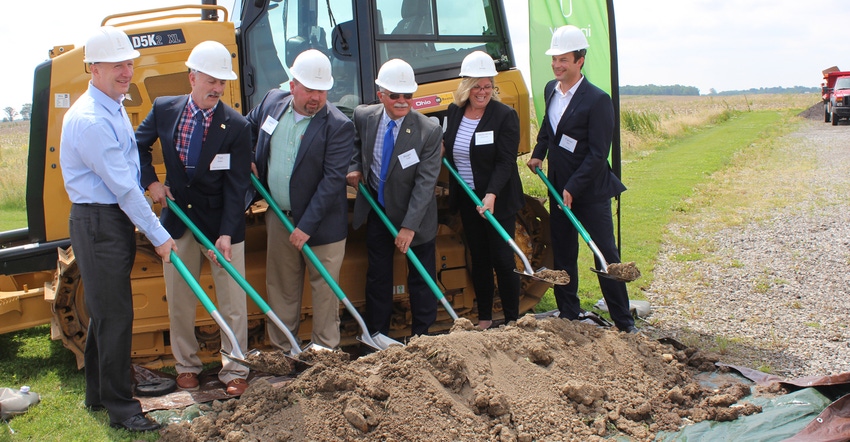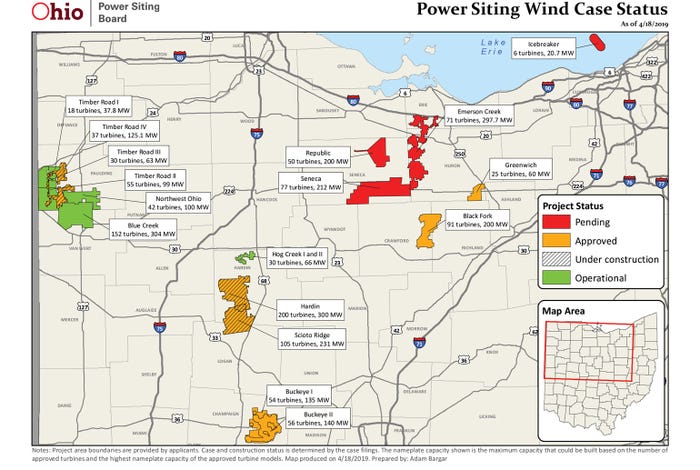
In the decade since large-scale wind farm development began in Ohio, the landscape has changed regarding those developments. In several areas of the state, the changes to the landscape are easy to see, with turbines turning above farm fields. But other projects, once planned, have been abandoned for a variety of reasons, including changes in setback requirements, public opposition, economic realities and political uncertainties.
Even so, some developers remain optimistic about the potential for wind power in Ohio and are moving forward with plans to build or expand wind farms.
Still uncommon, but use is growing
Although wind energy has been growing in Ohio, it still provides just a small fraction of the electricity used here. The U.S. Energy Information Administration estimates that wind provided 1.43% of the power in the state’s electric grid last year. Still, it’s the leading source of renewable energy for the electric grid. Solar, biomass and hydroelectric power each contributed less than 1%.
The Ohio Power Siting Board, which is responsible for regulating wind projects of 5 megawatts or more, counts 327 turbines in operation with a production capacity of 669.8 MW. Another 568 turbines have been approved for construction, and applications are pending on 204 more. In addition, there are a few smaller projects that don’t reach the 5-MW threshold, so they aren’t included in the Ohio Power Siting Board figures.
Most recently, Innogy Renewables U.S. broke ground on June 5 for a 250-megawatt project in Hardin and Logan counties that will have 75 turbines. The company expects the Scioto Ridge wind farm to be in operation by the end of 2020.
Pictured above at the Scioto Ridge wind farm groundbreaking are Andrew Young, Innogy Renewables U.S.; Tim Striker, Hardin County commissioner; Jason Dagger, Scioto Ridge project development manager; Roger Crowe, Hardin County commissioner; Jacqualine Fitzgerald, Hardin County Chamber and Business Alliance; and Fabian Gaus, Innogy Renewables U.S.
Innogy, a renewable energy company based in Germany, has been diversifying with projects around the world. The company came to Ohio last year when it purchased EverPower Wind, which was already working on plans for the Scioto Ridge wind farm.
“We have always looked for growth through new markets,” explains Fabian Gaus, chief financial officer for Innogy Renewables U.S. The project in Ohio is the company’s first in the U.S., and several others are in the planning stages, he says. “The United States holds great potential for renewable energy.”
State lures wind power developers
Ohio’s location within the mid-Atlantic region power pool is one factor that makes it attractive to wind power developers. Andrew Young, Innogy Renewables U.S. CEO, explains that electricity producers can sell energy into the grid through PGM Interconnection, which operates a wholesale marketplace for bulk sale of electricity. Then utility companies buy the power through PGM. “The state is in a great grid location, and it’s got a great wind resource,” he says.
Innogy has also built good working relationships with local and state officials, Young adds. In Hardin County, for instance, Innogy is working with the county engineer’s office to designate hauling routes for turbine construction. Innogy will be financing improvements to some bridges and culverts along the route.
Jason Dagger, project development manager for Scioto Ridge, calls the wind farm a “win-win” for the local economy. “You don’t see those projects come to the state very much, especially to a rural area like Logan and Hardin counties,” he says. The project is bringing $300 million in private investment to the area and will add $75 million in revenue to local governments, school districts and landowners over the next 25 years. About 100 families who own land in the project area will be receiving lease payments totaling $1 million per year.

This map shows the current wind farm projects and those under construction in Ohio.

Rules and incentives
As with any energy project, plans for wind projects must be approved by the Ohio Power Siting Board. One difference is that the OPSB oversees all wind projects above 5 megawatts, while the threshold for gas and solar projects is 50 megawatts. The process requires detailed plans and includes an independent review of the impact of the project, site visits and a public hearing.
The approval process also includes an adjudicatory hearing to hear input from the companies involved, local officials, landowners, other interested parties and organizations such as the Ohio Farm Bureau. Following approval, the OPSB monitors construction and operation of energy projects. The board is in the process of considering additional rules that would require wind energy companies to report incidents involving turbines, such as thrown blades.
While there is considerable public interest in renewable energy, there is also considerable public concern when projects are proposed. Dale Arnold, director of energy, utility and local government policy for the Ohio Farm Bureau, says public involvement has changed over the last 10 or 15 years, and now more people in the community expect to be involved in decisions about wind turbines and other energy projects.
“We’re seeing much more active discussion than in the past,” he notes. “People are wanting to know more about projects coming into their areas.”
Legal advice invaluable
Landowners who are approached by a wind developer, or any other energy company, concerning a lease for energy development need to consider the legal aspects and consult legal counsel, Arnold notes. “These are complex documents.”
Landowners often also consult with their minister, priest or other spiritual counselor, Arnold adds. A spiritual adviser can help the landowner sort through the moral and social implications of their decisions, and weigh the benefits and disadvantages of the development for their neighbors and community. Developers, public officials, neighbors and family members may all be offering their opinions on the matter. “Farmers see themselves as the center of a wagon wheel, with all these people coming at them,” he says.
Setback rule changes
One of the most common concerns about wind developments is setback requirements. Current Ohio law requires a setback of 1,125 feet plus the length of the blade, measuring from the nearest property line to the tip of the turbine blade when the blade is situated at 90 degrees. Adjacent landowners can agree to closer spacing by signing setback waivers.
Those setback rules were enacted by the Ohio Legislature in 2014, nearly tripling the setback requirement. That change made it more difficult for developers to build or expand wind farms in the state, says Jane Harf, executive director of Green Energy Ohio, a nonprofit organization that supports sustainable energy.
The state’s wind industry saw rapid expansion just before the change, and development slowed in the years afterward, Harf points out. “We would like to see those setback rules reinstated in their original form.”
Green Energy Ohio is also concerned about legislative efforts to repeal Ohio’s Renewable Energy Portfolio and Energy Efficiency Standards. “It’s basically making a statement on behalf of the government that we aren’t interested,” Harf explains.
Besides legislative debates about the Renewable Energy Standards, the state’s wind industry may also be affected by recent proposals to allow community referendums on wind energy projects.
Keck writes from Raymond, Ohio.
About the Author(s)
You May Also Like




